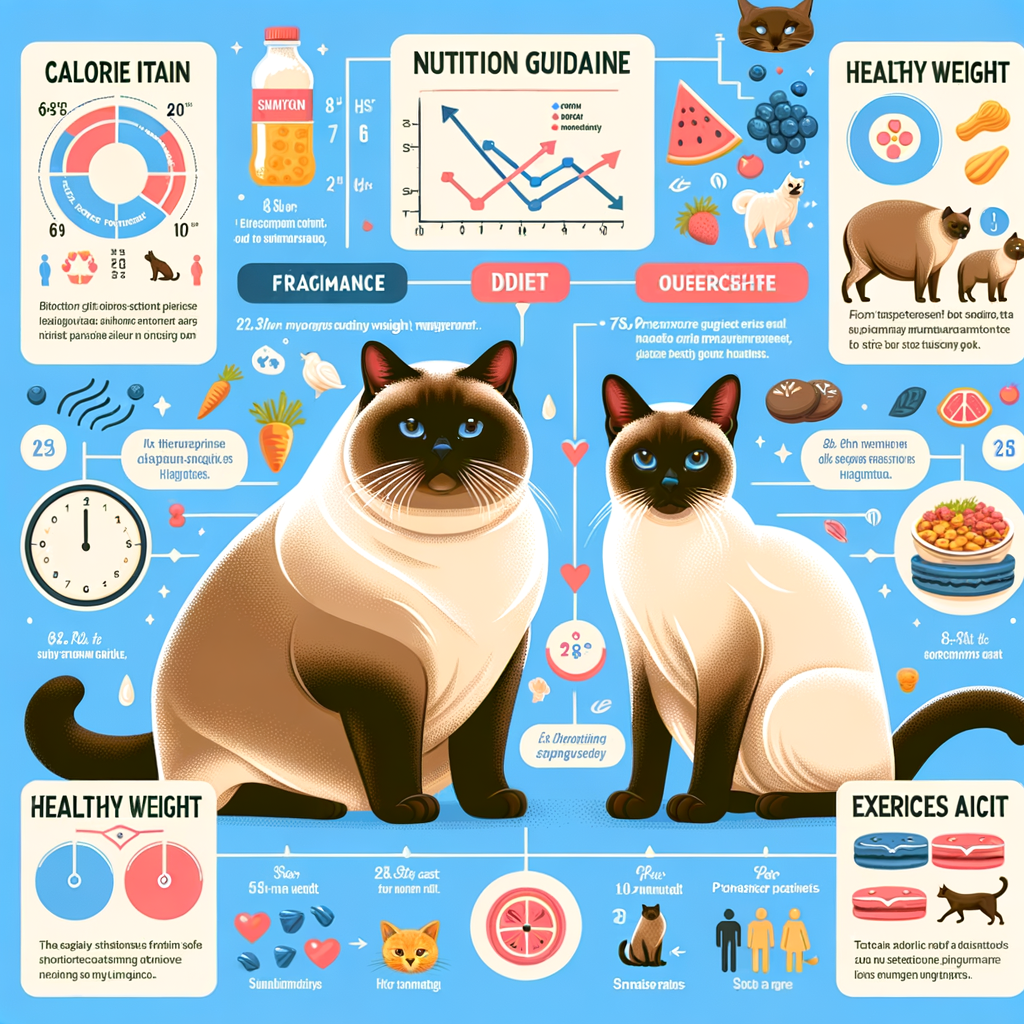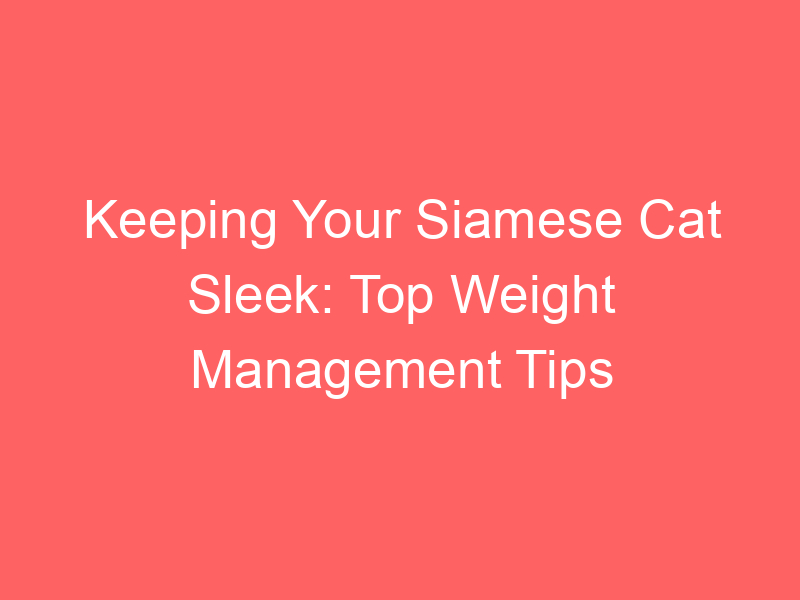
Introduction to Siamese Cat Weight Management
When it comes to the well-being of your Siamese cat, weight management plays a crucial role. Maintaining a healthy weight is not just about appearance, it’s about health, longevity, and quality of life. In this section, we will delve into the importance of weight management for Siamese cats and the common health issues that can arise from weight-related problems.
- Importance of maintaining a healthy weight for Siamese cats
- Common weight-related health issues in Siamese cats
Siamese cats, like all cats, need to maintain a healthy weight for optimal health. Overweight or underweight Siamese cats can face a variety of health issues that can affect their quality of life and lifespan. A healthy weight for a Siamese cat can vary depending on factors such as age, sex, and individual metabolism. However, a general guideline is that an adult Siamese cat should weigh between 8 to 12 pounds.
Keeping your Siamese cat at a healthy weight is not just about feeding them the right amount of food. It also involves providing them with the right type of food, ensuring they get enough exercise, and regularly monitoring their weight. By maintaining a healthy weight, you can help prevent a range of health issues and ensure your Siamese cat lives a long, happy life.
Siamese cats that are overweight or obese can face a variety of health problems. These can include diabetes, heart disease, arthritis, and even certain types of cancer. Overweight cats may also have a lower quality of life, as excess weight can make it harder for them to move around and engage in normal cat behaviors.
On the other hand, Siamese cats that are underweight can also face health issues. These can include malnutrition, weakened immune system, and increased susceptibility to infections and diseases. In severe cases, being underweight can also lead to organ failure and death.
In conclusion, maintaining a healthy weight is crucial for the overall health and well-being of your Siamese cat. By understanding the importance of weight management and being aware of the common weight-related health issues, you can take proactive steps to ensure your Siamese cat leads a healthy, happy life.
Understanding Siamese Cat Nutrition
When it comes to maintaining the health of your Siamese cat, understanding their nutritional needs is crucial. Just like us, cats require a balanced diet to stay healthy and active. Let’s delve into the essential nutrients that should be part of your Siamese cat’s diet.
Essential Nutrients for Siamese Cats
There are four main categories of nutrients that are vital for your Siamese cat’s health. These are:
- Protein: Protein is a vital nutrient for cats, especially Siamese cats. It helps in growth, repair, and maintenance of their body tissues. High-quality animal protein sources like chicken, fish, or beef should be included in their diet.
- Fats: Fats provide the most concentrated source of energy for cats. They are essential for the absorption of certain vitamins and also contribute to skin and coat health. Healthy sources of fats for cats include fish oil and chicken fat.
- Carbohydrates: While cats don’t require a lot of carbohydrates, some are beneficial for their overall health. They provide an additional source of energy and aid in digestion. Good sources of carbohydrates for cats include vegetables and certain grains.
- Vitamins and minerals: These are necessary for a range of bodily functions, including bone formation, vision, and blood clotting. Most commercial cat foods are fortified with the necessary vitamins and minerals, but it’s always a good idea to check the label.
Remember, every cat is unique and may have specific dietary needs. Always consult with your vet before making significant changes to your cat’s diet. By understanding and providing the right nutrition, you can ensure a long, healthy life for your Siamese cat.
Siamese Cat Diet: What to Feed Your Cat
When it comes to feeding your Siamese cat, there are several options to consider. Each has its own benefits and drawbacks, and the best choice will depend on your cat’s specific needs and your own lifestyle. Let’s explore three of the most common diet options: commercial cat food, homemade food, and a raw diet.
- Commercial Cat Food
- Homemade Food
- Raw Diet
Commercial cat food is a popular choice for many cat owners. It’s convenient, readily available, and comes in a variety of flavors that cats love. Most commercial cat foods are also nutritionally balanced, meaning they contain all the essential nutrients your Siamese cat needs to stay healthy. However, it’s important to choose a high-quality brand that uses real meat as the main ingredient and doesn’t contain too many fillers or artificial additives.
Some cat owners prefer to prepare their cat’s meals at home. This allows them to control exactly what goes into their cat’s diet and avoid any ingredients that may cause allergies or other health issues. Homemade food can be a good option if you have the time and knowledge to prepare balanced meals for your cat. However, it’s crucial to consult with a vet or a pet nutritionist to ensure your homemade meals meet all your cat’s nutritional needs.
A raw diet, also known as a ‘biologically appropriate raw food’ or ‘BARF’ diet, involves feeding your cat raw meat and bones. This type of diet aims to mimic the natural diet of wild cats and can be beneficial for your Siamese cat’s dental health and digestion. However, a raw diet also has potential risks, including bacterial contamination and an unbalanced diet if not properly prepared. Therefore, it’s essential to do thorough research and consult with a professional before switching your cat to a raw diet.
In conclusion, the best diet for your Siamese cat will depend on various factors, including your cat’s age, health status, and personal preferences, as well as your own lifestyle and budget. Always consult with a vet before making any significant changes to your cat’s diet.
Weight Control for Siamese Cats
Keeping your Siamese cat at a healthy weight is crucial for their overall health and longevity. This section will guide you on how to identify if your Siamese cat is overweight and the physical and behavioral signs to look out for.
Identifying an Overweight Siamese Cat
Recognizing an overweight Siamese cat can be a bit tricky, especially if you see your pet every day. However, there are certain physical and behavioral changes that you can observe.
- Physical signs: An overweight Siamese cat may have difficulty grooming itself, especially around the back and hindquarters. You might also notice that your cat’s waistline is less defined, and the belly may sag. If you can’t feel your cat’s ribs when you gently press on their sides, it could be a sign that your cat is overweight.
- Behavioral changes: Overweight cats may show changes in their behavior. They might become less active, show difficulty in jumping or climbing, or sleep more than usual. If your Siamese cat is eating more than usual but still seems hungry, this could also be a sign of being overweight.
It’s important to remember that these signs could also indicate other health issues. If you notice any of these changes in your Siamese cat, it’s best to consult with your vet.
Siamese Cat Weight Loss Strategies
When it comes to managing the weight of your Siamese cat, there are three main strategies that you can adopt. These strategies are not only effective but also easy to implement. They include adjusting calorie intake, increasing physical activity, and scheduling regular vet check-ups.
- Adjusting Calorie Intake
One of the most effective ways to help your Siamese cat lose weight is by adjusting their calorie intake. This involves feeding them a balanced diet that meets their nutritional needs but does not exceed their daily calorie requirements. For instance, an average adult Siamese cat requires about 20 calories per pound of body weight. Therefore, if your cat weighs 10 pounds, they should consume about 200 calories per day. However, if your cat is overweight, you may need to reduce their calorie intake by about 10-20% to help them lose weight.
- Increasing Physical Activity
Increasing your Siamese cat’s physical activity is another effective weight loss strategy. This can be achieved by engaging your cat in fun and interactive play sessions. For instance, you can use toys like laser pointers, feather wands, or even a simple ball of yarn to get your cat moving. Remember, the goal is to keep your cat active for at least 15-30 minutes per day. This will not only help them burn calories but also keep them mentally stimulated.
- Regular Vet Check-ups
Regular vet check-ups are crucial in monitoring your Siamese cat’s weight loss progress. Your vet will be able to provide you with accurate weight measurements and advise you on the best diet and exercise plan for your cat. Additionally, regular vet visits can help detect any underlying health issues that may be contributing to your cat’s weight gain.
In conclusion, managing your Siamese cat’s weight involves a combination of a balanced diet, regular exercise, and routine vet check-ups. By following these strategies, you can ensure that your Siamese cat maintains a healthy weight and lives a long, happy life.
Feeding Strategies for Siamese Cats
One of the most important aspects of caring for your Siamese cat is understanding how to feed them properly. This involves not only choosing the right food but also controlling the portions and frequency of meals. In this section, we will focus on portion control.
Portion Control
Portion control is crucial in maintaining your Siamese cat’s weight and overall health. Overfeeding can lead to obesity, which can cause a host of health problems. On the other hand, underfeeding can lead to malnutrition. Here are some key points to consider:
- Understanding cat food labels
- Measuring food portions
Cat food labels can be confusing, but it’s important to understand them to ensure your Siamese cat is getting the right nutrients. Look for labels that indicate the food is complete and balanced, meaning it contains all the nutrients your cat needs. The label should also show the recommended serving size based on your cat’s weight.
Once you understand the food labels, the next step is to measure the food portions accurately. Use a standard measuring cup or a kitchen scale for this. Remember, the recommended serving size on the label is usually for the entire day, so you’ll need to divide it into the number of meals you feed your cat each day.
Portion control is a critical part of your Siamese cat’s feeding strategy. By understanding cat food labels and accurately measuring food portions, you can ensure your cat is getting the right amount of food and nutrients they need to stay healthy.
Meal Frequency
One of the most important aspects of feeding your Siamese cat is the frequency of meals. The number of times you feed your cat can significantly impact their health and weight. Let’s delve into this topic further.
- Feeding Your Siamese Cat Multiple Small Meals
Feeding your Siamese cat multiple small meals throughout the day can be beneficial. This method of feeding can help maintain a steady blood sugar level and prevent overeating. It’s similar to how humans eat; having several small meals can be healthier than having one or two large ones.
For instance, you might consider feeding your Siamese cat four to five small meals a day. This can include a mix of dry and wet food to ensure they’re getting a balanced diet. Remember, the key is to keep the meals small to avoid overfeeding.
- Free Feeding vs Scheduled Feeding
When it comes to feeding your Siamese cat, you have two main options: free feeding and scheduled feeding. Free feeding means leaving food out all day for your cat to eat whenever they want. On the other hand, scheduled feeding involves providing meals at specific times.
While free feeding might seem convenient, it can lead to weight gain and obesity in cats. This is because cats often eat out of boredom rather than hunger. In contrast, scheduled feeding allows you to control the amount your cat eats and can help prevent overeating.
In conclusion, feeding your Siamese cat multiple small meals and sticking to a feeding schedule can help maintain a healthy weight and prevent obesity. Remember, every cat is unique, so it’s essential to monitor your cat’s weight and adjust their feeding schedule as needed.
Siamese Cat Exercise: Keeping Your Cat Active
Exercise is an essential part of a Siamese cat’s life. It helps maintain a healthy weight, improves their mood, and keeps them physically and mentally stimulated. Here are some effective ways to keep your Siamese cat active and healthy:
- Interactive Toys
Interactive toys are a great way to keep your Siamese cat active. These toys are designed to stimulate your cat’s natural hunting instincts, which can help them burn off energy and stay mentally stimulated. For example, a laser pointer can provide hours of fun for your cat as they chase the elusive red dot. Puzzle toys that dispense treats can also keep your cat engaged as they work to solve the puzzle and get their reward. Remember, the key is to find toys that your cat enjoys and will want to play with regularly.
- Outdoor Play
Allowing your Siamese cat to play outside can provide a wealth of opportunities for exercise. They can climb trees, chase bugs, or simply run around. However, it’s important to ensure their safety while they’re outside. A fenced-in yard or a cat enclosure can provide a safe environment for your cat to explore and play. Always supervise your cat while they’re outside to protect them from potential dangers.
- Cat Agility Training
Agility training is not just for dogs! Siamese cats are known for their agility and intelligence, making them perfect candidates for this type of training. You can set up an agility course in your home with tunnels, jumps, and weave poles. Training your cat to navigate the course can provide both physical exercise and mental stimulation. Plus, it’s a great way to bond with your cat!
In conclusion, keeping your Siamese cat active is crucial for their overall health and well-being. By incorporating interactive toys, outdoor play, and agility training into their routine, you can ensure they get the exercise they need while also keeping them mentally stimulated. Remember, a healthy and active Siamese cat is a happy Siamese cat!
Preventing Obesity in Siamese Cats
Obesity is a common health issue among pets, and Siamese cats are no exception. However, with the right approach, it’s possible to prevent this condition and ensure your feline friend leads a healthy, active life. The key to preventing obesity in Siamese cats lies in early intervention and long-term strategies.
Early Intervention
Early intervention is crucial in preventing obesity in Siamese cats. This involves two main steps: monitoring your cat’s weight from kittenhood and regular vet check-ups.
- Monitoring your Siamese cat’s weight from kittenhood: It’s important to keep a close eye on your Siamese cat’s weight from a young age. This will help you notice any sudden weight gain and take action before it becomes a problem. Remember, a healthy Siamese cat should weigh between 8 to 10 pounds. Anything above this could be a sign of obesity.
- Regular vet check-ups: Regular vet visits are essential for early detection of weight issues. Your vet can provide a professional assessment of your cat’s weight and offer advice on diet and exercise. It’s recommended to have your Siamese cat checked at least once a year.
By implementing these early intervention strategies, you can help your Siamese cat maintain a healthy weight and prevent obesity. Remember, prevention is always better than cure. Start monitoring your cat’s weight and scheduling regular vet check-ups today to ensure a healthy future for your feline friend.
Long-Term Strategies
When it comes to preventing obesity in Siamese cats, there are two long-term strategies that are crucial. These include maintaining a balanced diet and ensuring regular exercise. Let’s delve into each of these strategies in detail:
- Maintaining a Balanced Diet
Feeding your Siamese cat a balanced diet is one of the most effective ways to prevent obesity. A balanced diet for a Siamese cat should include a mix of proteins, fats, and carbohydrates. Proteins are essential for growth and repair, fats provide energy, and carbohydrates are necessary for digestion and absorption of nutrients.
It’s also important to control portion sizes. Overfeeding can lead to weight gain, even if the food is healthy. A good rule of thumb is to feed your Siamese cat about 20 calories per pound of body weight per day. This can vary depending on the cat’s age, activity level, and overall health.
| Food Type | Percentage in Diet |
|---|---|
| Proteins | 40-50% |
| Fats | 20-30% |
| Carbohydrates | 30-40% |
- Ensuring Regular Exercise
Exercise is another key component in preventing obesity in Siamese cats. Regular physical activity helps burn calories, maintain muscle mass, and promote overall health. Siamese cats are known for their playful and energetic nature, so they should have plenty of opportunities for exercise.
Interactive toys, climbing trees, and laser pointers can all provide great exercise for your Siamese cat. Aim for at least 15-20 minutes of active playtime each day. Remember, exercise should be fun for your cat, so try different activities until you find what they enjoy the most.
By implementing these long-term strategies, you can help ensure your Siamese cat maintains a healthy weight and lives a long, happy life.
Conclusion: Ensuring a Healthy Life for Your Siamese Cat
As we draw this discussion to a close, it’s essential to remember that maintaining your Siamese cat’s weight is a crucial part of ensuring their overall health and longevity. Let’s take a moment to recap some of the key points we’ve covered.
- Recap of weight management tips for Siamese cats: Siamese cats, known for their sleek and athletic build, require a balanced diet and regular exercise to maintain their ideal weight. Overfeeding or under-exercising your Siamese cat can lead to obesity, which can cause a host of health problems. Some of the weight management tips we’ve discussed include portion control, feeding a balanced diet rich in protein and low in carbohydrates, and encouraging regular play and exercise.
- Importance of consistency in diet and exercise: Consistency is key when it comes to managing your Siamese cat’s weight. Establishing a regular feeding and exercise routine can help prevent weight gain and promote overall health. Remember, sudden changes in diet or exercise can be stressful for your cat, so it’s important to introduce any changes gradually and monitor your cat’s response.
By following these guidelines, you can help ensure that your Siamese cat maintains a healthy weight and lives a long, happy life. Remember, every cat is unique, so it’s important to tailor these strategies to your cat’s specific needs and preferences. Consult with your vet regularly to ensure your cat’s diet and exercise routine is suitable for their age, health status, and lifestyle.








